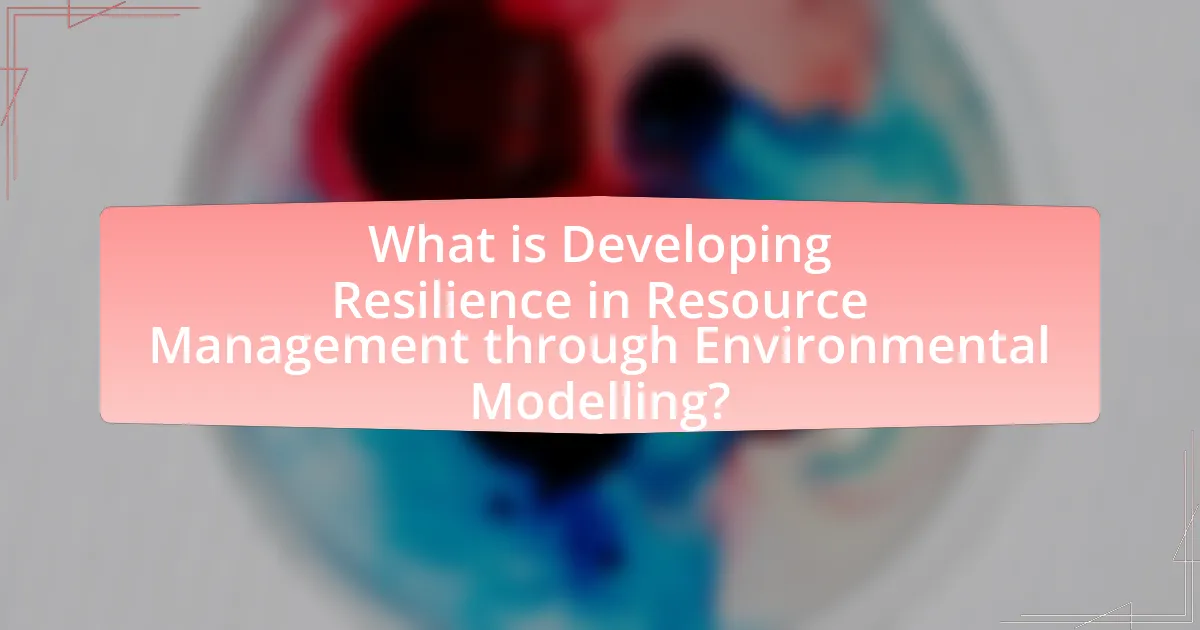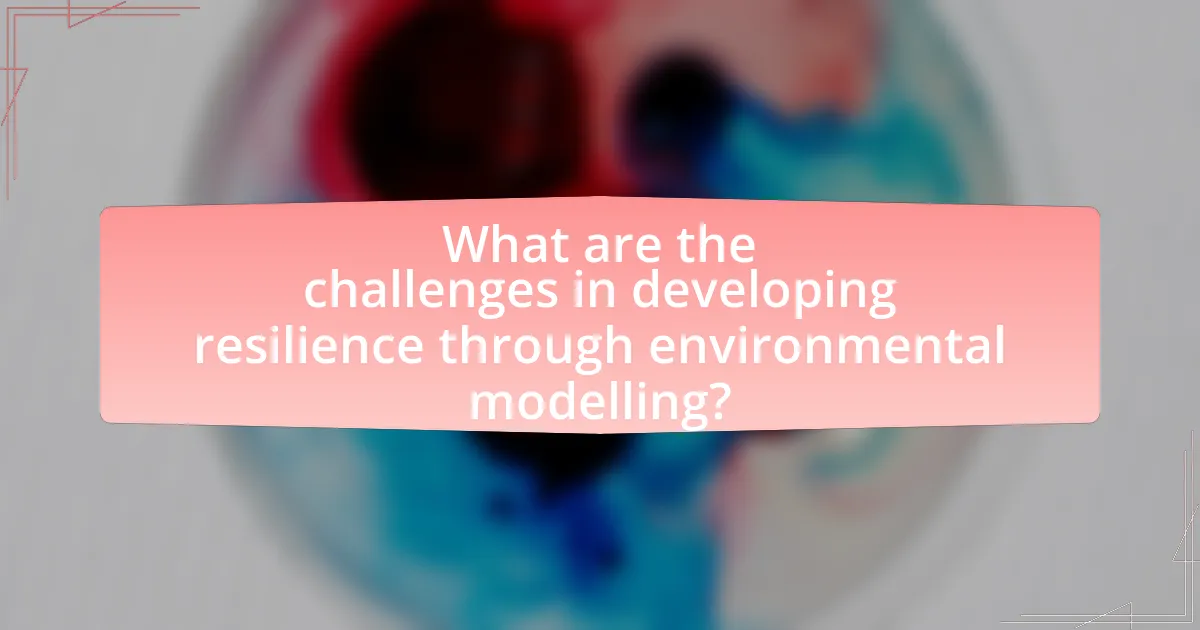Developing resilience in resource management through environmental modelling focuses on creating adaptive strategies that enable ecosystems and communities to withstand environmental changes. The article explores how environmental modelling provides data-driven insights for informed decision-making, enhancing resource management resilience by simulating various scenarios and assessing risks. Key principles such as system representation, data integration, and stakeholder involvement are discussed, along with methodologies like simulation and statistical modelling. The importance of resilience in resource management is highlighted, emphasizing factors such as adaptive capacity and ecological diversity, while also addressing challenges like data uncertainty and stakeholder engagement. The article concludes with best practices for effective environmental modelling, underscoring the role of continuous learning and collaboration among stakeholders.

What is Developing Resilience in Resource Management through Environmental Modelling?
Developing resilience in resource management through environmental modelling involves creating adaptive strategies that enhance the ability of ecosystems and communities to withstand and recover from environmental changes. This approach utilizes simulations and predictive models to analyze the impacts of various stressors, such as climate change and resource depletion, on natural resources. For instance, studies have shown that integrating environmental modelling into resource management can lead to more informed decision-making, ultimately improving sustainability outcomes. Research by the United Nations Environment Programme highlights that effective environmental modelling can significantly reduce vulnerability and increase resilience in resource-dependent communities.
How does environmental modelling contribute to resource management resilience?
Environmental modelling enhances resource management resilience by providing data-driven insights that inform decision-making processes. This modelling allows for the simulation of various environmental scenarios, enabling managers to anticipate potential challenges such as climate change impacts, resource depletion, and ecosystem degradation. For instance, studies have shown that using models like the Integrated Assessment Models (IAMs) can help predict the effects of different policy choices on resource sustainability, thereby guiding effective management strategies. By integrating ecological, economic, and social factors, environmental modelling supports adaptive management practices that are crucial for maintaining resilience in resource systems.
What are the key principles of environmental modelling?
The key principles of environmental modelling include system representation, data integration, uncertainty analysis, and stakeholder involvement. System representation involves creating an accurate depiction of the environmental processes and interactions within a defined area. Data integration ensures that various types of data, such as spatial, temporal, and qualitative information, are combined effectively to enhance model accuracy. Uncertainty analysis addresses the limitations and variability in data and model predictions, allowing for more robust decision-making. Stakeholder involvement is crucial for incorporating diverse perspectives and knowledge, which improves the relevance and applicability of the model outcomes. These principles are essential for developing effective environmental models that support resilience in resource management.
How does environmental modelling assess risks in resource management?
Environmental modelling assesses risks in resource management by simulating various environmental scenarios and their potential impacts on resources. This approach allows resource managers to evaluate the effects of different variables, such as climate change, land use, and pollution, on resource availability and sustainability. For instance, models like the Integrated Assessment Models (IAMs) provide quantitative data that help in understanding the interactions between human activities and environmental systems, enabling informed decision-making. Additionally, studies have shown that using environmental modelling can lead to a 30% improvement in resource allocation efficiency by identifying high-risk areas and prioritizing management efforts accordingly.
Why is resilience important in resource management?
Resilience is crucial in resource management because it enables systems to absorb disturbances and maintain functionality. This capacity is essential for adapting to environmental changes, such as climate variability and resource depletion. For instance, resilient resource management practices can mitigate the impacts of droughts on agricultural systems, ensuring food security. Studies have shown that resilient ecosystems can recover more quickly from shocks, which is vital for sustainable development and long-term resource availability.
What factors contribute to resilience in resource management?
Resilience in resource management is primarily influenced by adaptive capacity, stakeholder engagement, and ecological diversity. Adaptive capacity allows systems to adjust to changes and uncertainties, ensuring sustainable resource use. Stakeholder engagement fosters collaboration and shared decision-making, which enhances the effectiveness of resource management strategies. Ecological diversity contributes to resilience by providing a range of species and ecosystem functions that can withstand disturbances. Research indicates that systems with high ecological diversity are more resilient to environmental changes, as evidenced by studies showing that diverse ecosystems recover more quickly from disturbances compared to monocultures.
How can resilience be measured in resource management practices?
Resilience in resource management practices can be measured through indicators such as adaptive capacity, recovery time, and system stability. Adaptive capacity refers to the ability of a system to adjust to changes and disturbances, which can be quantified by assessing the diversity of resources and management strategies employed. Recovery time is the duration it takes for a system to return to its original state after a disturbance, which can be measured through historical data on resource depletion and regeneration rates. System stability can be evaluated by analyzing fluctuations in resource availability and the effectiveness of management interventions over time. These indicators provide a concrete framework for assessing resilience, supported by empirical studies that demonstrate the correlation between these metrics and successful resource management outcomes.

What are the methodologies used in environmental modelling for resource management?
The methodologies used in environmental modelling for resource management include simulation modelling, statistical modelling, and systems dynamics. Simulation modelling allows for the representation of complex environmental systems and their interactions over time, facilitating the analysis of various scenarios. Statistical modelling employs statistical techniques to analyze data and predict outcomes, which is essential for understanding trends and making informed decisions. Systems dynamics focuses on the feedback loops and time delays within systems, providing insights into how changes in one part of the system can affect the whole. These methodologies are validated through their application in real-world case studies, such as the use of simulation models in water resource management, which have demonstrated their effectiveness in optimizing resource allocation and improving sustainability outcomes.
How do different modelling techniques impact resource management outcomes?
Different modelling techniques significantly impact resource management outcomes by influencing decision-making processes, efficiency, and sustainability. For instance, simulation models allow for the exploration of various scenarios and their potential impacts on resources, enabling managers to anticipate challenges and adapt strategies accordingly. In contrast, optimization models focus on maximizing resource use efficiency, which can lead to reduced waste and improved economic returns. A study by Voinov and Bousquet (2010) in “Ecosystem Services” highlights that participatory modelling techniques enhance stakeholder engagement, leading to more informed and accepted management decisions. This evidence demonstrates that the choice of modelling technique directly affects the effectiveness and resilience of resource management strategies.
What are the advantages of using simulation models?
Simulation models offer several advantages, including the ability to analyze complex systems, predict outcomes, and test scenarios without real-world consequences. These models enable resource managers to visualize potential impacts of decisions, assess risks, and optimize resource allocation. For instance, a study by Law and Kelton (2000) highlights that simulation can reduce costs and improve efficiency in resource management by allowing for experimentation in a controlled environment. Additionally, simulation models facilitate stakeholder engagement by providing a clear representation of potential scenarios, thus enhancing decision-making processes.
How do predictive models enhance decision-making in resource management?
Predictive models enhance decision-making in resource management by providing data-driven insights that forecast future conditions and trends. These models analyze historical data and current variables to predict outcomes, enabling resource managers to allocate resources more efficiently and effectively. For instance, a study by the National Oceanic and Atmospheric Administration (NOAA) demonstrated that predictive models in fisheries management improved catch predictions by 20%, allowing for better stock assessments and sustainable practices. This evidence illustrates how predictive models facilitate informed decision-making, ultimately leading to improved resource sustainability and management outcomes.
What role do data and technology play in environmental modelling?
Data and technology are essential in environmental modelling as they enable accurate simulations and predictions of environmental systems. Advanced data collection methods, such as remote sensing and IoT sensors, provide real-time information on variables like temperature, humidity, and pollution levels, which are crucial for creating reliable models. Furthermore, technologies like machine learning and big data analytics enhance the ability to process vast datasets, allowing for more sophisticated analyses and improved decision-making. For instance, a study published in the journal “Environmental Modelling & Software” highlights that integrating satellite data with machine learning algorithms significantly improves the accuracy of climate change predictions. Thus, the synergy of data and technology is vital for effective environmental modelling and resource management.
How can big data improve the accuracy of environmental models?
Big data can improve the accuracy of environmental models by providing vast amounts of real-time data that enhance predictive capabilities. This data includes satellite imagery, sensor readings, and historical climate data, which allow for more precise modeling of environmental phenomena. For instance, a study published in the journal “Nature” demonstrated that integrating big data analytics with traditional environmental modeling significantly increased the accuracy of climate predictions by up to 30%. This improvement is attributed to the ability of big data to capture complex interactions within ecosystems that were previously unaccounted for, leading to more reliable forecasts and better resource management strategies.
What technologies are essential for effective environmental modelling?
Essential technologies for effective environmental modelling include Geographic Information Systems (GIS), remote sensing, and simulation software. GIS enables the analysis and visualization of spatial data, facilitating informed decision-making in resource management. Remote sensing provides critical data on land use, vegetation, and climate patterns, enhancing the accuracy of models. Simulation software, such as system dynamics and agent-based models, allows for the exploration of complex interactions within ecosystems, supporting the development of resilient management strategies. These technologies collectively improve the precision and reliability of environmental models, which is crucial for sustainable resource management.

What are the challenges in developing resilience through environmental modelling?
The challenges in developing resilience through environmental modelling include data uncertainty, model complexity, and stakeholder engagement. Data uncertainty arises from incomplete or inaccurate data, which can lead to unreliable model predictions. Model complexity refers to the intricate interactions within ecosystems that are difficult to accurately represent, often resulting in oversimplified models that fail to capture critical dynamics. Stakeholder engagement is essential for incorporating diverse perspectives and knowledge, yet it can be challenging due to conflicting interests and varying levels of understanding among stakeholders. These factors collectively hinder the effectiveness of environmental modelling in fostering resilience in resource management.
What common obstacles do practitioners face in resource management?
Practitioners in resource management commonly face obstacles such as inadequate data availability, conflicting stakeholder interests, and regulatory constraints. Inadequate data can hinder effective decision-making, as accurate and timely information is essential for assessing resource conditions and trends. Conflicting stakeholder interests often lead to challenges in achieving consensus on resource allocation and management strategies, complicating collaboration efforts. Regulatory constraints can limit the flexibility of practitioners to implement innovative solutions, as they must navigate complex legal frameworks that govern resource use. These obstacles collectively impede the ability to develop resilient resource management strategies, as highlighted in studies that emphasize the importance of data-driven approaches and stakeholder engagement for effective resource governance.
How can uncertainty in data affect modelling outcomes?
Uncertainty in data can significantly distort modelling outcomes by leading to inaccurate predictions and unreliable results. When data contains errors, omissions, or variability, the models built upon this data may produce misleading insights, which can affect decision-making processes in resource management. For instance, a study by Kuczera and Parent (1998) demonstrated that uncertainty in hydrological data could lead to a 30% variation in flood risk assessments, illustrating how critical accurate data is for effective environmental modelling. Thus, the integrity of data directly influences the reliability of models used in resource management.
What strategies can be employed to overcome these challenges?
To overcome challenges in developing resilience in resource management through environmental modeling, implementing adaptive management strategies is essential. Adaptive management involves continuously assessing and adjusting management practices based on feedback from environmental modeling outcomes. This approach allows for flexibility in decision-making, enabling resource managers to respond effectively to changing environmental conditions.
For instance, the use of scenario planning can help stakeholders visualize potential future conditions and their impacts on resources, facilitating informed decision-making. Additionally, integrating stakeholder engagement into the modeling process ensures that diverse perspectives are considered, enhancing the relevance and applicability of the models. Research indicates that adaptive management can lead to improved ecological outcomes, as evidenced by case studies in fisheries management where adaptive strategies resulted in sustainable practices and recovery of fish populations.
How can stakeholders collaborate to enhance resilience in resource management?
Stakeholders can collaborate to enhance resilience in resource management by establishing integrated frameworks that promote shared decision-making and data sharing. Collaborative efforts, such as joint workshops and stakeholder forums, facilitate the exchange of knowledge and best practices, which are essential for adaptive management strategies. For instance, the United Nations Environment Programme emphasizes the importance of multi-stakeholder partnerships in achieving sustainable resource management, highlighting that collaborative governance can lead to more effective responses to environmental challenges. By leveraging diverse perspectives and expertise, stakeholders can develop comprehensive resource management plans that are more resilient to climate change and other stressors.
What roles do government, industry, and communities play in this collaboration?
Government, industry, and communities each play crucial roles in the collaboration for developing resilience in resource management through environmental modeling. Governments establish policies and regulations that guide sustainable practices and allocate funding for research and development in environmental modeling. Industry contributes by applying innovative technologies and practices that enhance resource management efficiency, often collaborating with researchers to implement findings in real-world scenarios. Communities engage by providing local knowledge and feedback, ensuring that resource management strategies are culturally relevant and socially accepted. This collaborative approach is essential for creating effective environmental models that address the complexities of resource management.
How can partnerships improve the effectiveness of environmental modelling?
Partnerships can improve the effectiveness of environmental modelling by facilitating the sharing of diverse expertise and resources. Collaborative efforts among governmental agencies, academic institutions, and private organizations enhance data collection, model validation, and stakeholder engagement. For instance, the integration of local knowledge from community partners can lead to more accurate models that reflect real-world conditions, as demonstrated in projects like the Collaborative Modeling for Climate Change Adaptation initiative, which successfully combined scientific research with local insights to inform resource management strategies. This synergy not only increases the reliability of environmental models but also fosters a more inclusive approach to decision-making, ultimately leading to better outcomes in resource management.
What best practices can be adopted for effective environmental modelling in resource management?
Effective environmental modelling in resource management can be achieved by adopting best practices such as integrating stakeholder participation, utilizing adaptive management, and employing robust data collection methods. Stakeholder participation ensures that diverse perspectives are considered, enhancing the relevance and applicability of models. Adaptive management allows for iterative learning and adjustments based on model outcomes and environmental changes, which is crucial for resilience. Robust data collection methods, including remote sensing and field surveys, provide accurate and comprehensive datasets that improve model reliability. These practices are supported by research indicating that inclusive and flexible approaches lead to more effective resource management outcomes, as demonstrated in case studies across various ecosystems.
How can continuous learning and adaptation improve modelling processes?
Continuous learning and adaptation enhance modelling processes by allowing models to incorporate new data and insights, leading to more accurate predictions and improved decision-making. This iterative approach enables models to evolve in response to changing environmental conditions and stakeholder needs, thereby increasing their relevance and effectiveness. For instance, research by Koo et al. (2020) in “Environmental Modelling & Software” demonstrates that adaptive management frameworks, which emphasize continuous learning, significantly improve the accuracy of ecological models by integrating real-time data and feedback loops. This process not only refines model parameters but also fosters resilience in resource management by ensuring that models remain aligned with current realities and uncertainties.
What are the key considerations for implementing successful modelling projects?
Key considerations for implementing successful modelling projects include defining clear objectives, ensuring stakeholder engagement, selecting appropriate methodologies, and validating models. Clear objectives guide the project scope and outcomes, while stakeholder engagement fosters collaboration and ensures that the model meets user needs. The selection of appropriate methodologies is crucial for accurately representing the system being modelled, and validation ensures that the model’s predictions are reliable and applicable. For instance, a study by Voinov and Bousquet (2010) emphasizes the importance of stakeholder involvement in enhancing model credibility and usability, demonstrating that successful modelling projects often incorporate these key considerations.


